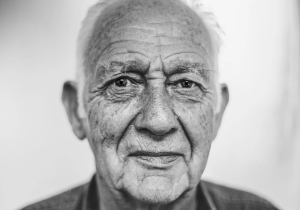Open Resources for Nursing (Open RN)
Learning Activities
(Answers to “Learning Activities” can be found in the “Answer Key” at the end of the book. Answers to interactive activity elements will be provided within the element as immediate feedback.)
Assessing a client’s risk for falls and planning interventions to prevent falls are common safety strategies completed by nurses. This section uses a client scenario to demonstrate how to use the nursing process to assess a client and then create a nursing care plan to prevent falls. Begin by reading the Handoff Report received from the nurse on the previous shift.

Handoff Report
Mr. Moore is a 72-year-old widower recovering in the hospital after sustaining injuries he received from a fall at home. See Figure 5.15 for an image of Mr. Moore.[1] He fractured his right hip and underwent surgical repair two days ago. He is receiving IV fluids and morphine for pain control. He has a history of hypertension and cardiovascular disease. He wears glasses and hearing aids. Per recommendations from the physical therapist, he is able to transfer with one assist with a walker but is weak on his right side. He has an order to ambulate at least 100 feet four times daily with a wheeled walker. He is 6 feet tall and weighs 165 pounds. Prior to the fall, he lived at home alone independently, and he is looking forward to returning home.
Assessment
The nurse collects the following assessment findings:
- Vital Signs: Blood pressure 90/60, heart rate 56, respiratory rate 18, temperature 37 degrees Celsius, pulse oximetry reading 92%, current pain level 0
- Alert and oriented x 3 to person, place, and time
- Lungs clear
- Cardiovascular Assessment: Heart rate is regular, capillary refill less than 3 seconds in fingers and toes, pedal pulses 2+
- Right lower extremity strength is 1+ (weak)
- Ambulates with walker with assistance; gait is unsteady
Critical Thinking Questions
1. Describe the fall risk factors for Mr. Moore.
2. Use the Morse Fall Risk Scale to assess Mr. Moore’s risk for falling.
Diagnosis
The NANDA-I nursing diagnosis is established: Risk for Falls as evidenced by lower extremity weakness and difficulty with gait.
Outcome Identification
Overall Goal: Mr. Moore will remain free from falls during his hospitalization stay.
SMART Expected Outcomes:
- Mr. Moore will not experience a fall during hospitalization.
- Mr. Moore will correctly use his assistive device (walker) every time he ambulates during hospitalization.
Planning Interventions
The following interventions are planned based on Mr. Moore’s fall risk factors.
- Remove clutter from the floor.
- Provide adequate lighting with a night-light at the bedside.
- Use half side rails to prevent falls from the bed.
- Monitor gait, balance, and fatigue with ambulation and encourage resting as needed.
- Place personal items within easy reach of the client at the bedside.
- Provide an elevated toilet seat.
- Encourage the use of prescribed glasses and hearing aids when walking.
- Obtain orthostatic blood pressures daily and notify the provider as indicated.
- Ensure the client wears shoes that fit properly, are fastened securely, and have no-skid soles.
- Suggest home adaptations to improve safety after discharge, such as adjusting the toilet seat height, installing grab bars in the bathroom, and using a rubber mat in the shower.
Critical Thinking Question
3. What additional interventions could be implemented for Mr. Moore to reduce his risk of falls that target his specific risk factors?
Implementation of Interventions
The following day, upon entering the room, you find Mr. Moore has climbed out of bed and is on his way to the bathroom. He states, “I need to go to the bathroom for a bowel movement and didn’t have time to ring the call light and wait.” You assist him with his walker, but he seems unsteady on his feet as he walks toward the bathroom. You’re not sure if he will make it to the toilet without falling. He says, “We need to hurry or I’m not going to make it.”
Critical Thinking Question
4. What is the best response?
Evaluation
The nurse evaluates Mr. Moore’s progress based on the established expected outcomes:
- Mr. Moore will not experience a fall during hospitalization: Outcome Met.
- Mr. Moore will use his assistive device (walker) correctly during hospitalization: Outcome Partially Met.
Mr. Moore forgets to call for assistance and uses a walker when he needs to go to the bathroom. A “stop” sign has been placed within client view to remind him to use the call light before getting up. In addition to hourly rounding, toileting will be performed at scheduled intervals every two hours. An icon has been posted on the doorframe to alert staff that the client is at high risk for falls. In addition to the bed being kept low and locked, a mat will be placed next to the bed at night. If Mr. Moore continues to forget to call for assistance, a bed alarm will be placed to alert staff of movement so that quick assistance can be offered.
- “old-man-1208210_960_720.jpg” by Free-Photos at Pixabay is licensed under CC0 ↵

